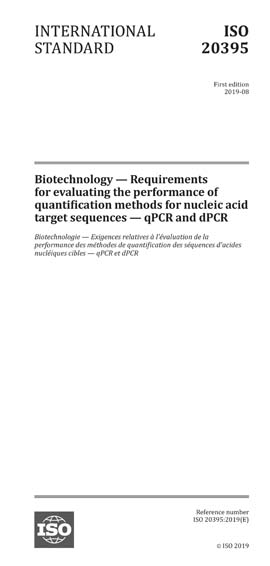Most recent
ISO 20395:2019
Biotechnology - Requirements for evaluating the performance of quantification methods for nucleic acid target sequences - qPCR and dPCR
This document provides generic requirements for evaluating the performance and ensuring the quality of methods used for the quantification of specific nucleic acid sequences (targets).
This document is applicable to the quantification of DNA (deoxyribonucleic acid) and RNA (ribonucleic acid) target sequences using either digital (dPCR) or quantitative real-time PCR (qPCR) amplification technologies. It applies to target sequences present in nucleic acid molecules including double-stranded DNA (dsDNA) such as genomic DNA (gDNA) and plasmid DNA, single stranded DNA (ssDNA), complementary DNA (cDNA), and single stranded RNA (ssRNA) including ribosomal RNA (rRNA), messenger RNA (mRNA), and long and short non-coding RNA [microRNAs (miRNAs) and short interfering RNAs (siRNAs)], as well as double-stranded RNA (dsRNA).
This document applies to nucleic acids derived from biological sources such as viruses, prokaryotic and eukaryotic cells, cell-free biological fluids (e.g. plasma or cell media) or in vitro sources [e.g. oligonucleotides, synthetic gene constructs and in vitro transcribed (IVT) RNA].
This document is not applicable to quantification of very short DNA oligonucleotides (<50 bases).
This document covers:
— analytical design including quantification strategies (nucleic acid copy number quantification using a calibration curve as in qPCR or through molecular counting as in dPCR, quantification relative to an independent sample and ratio measurements) and use of controls;
— quantification of total nucleic acid mass concentration and quality control of a nucleic acid sample including assessment of nucleic acid quality (purity and integrity);
— PCR assay design, optimization, in silico and in vitro specificity testing;
— data quality control and analysis including acceptance criteria, threshold setting and normalization;
— method validation (precision, linearity, limit of quantification, limit of detection, trueness and robustness) with specific requirements for qPCR and dPCR;
— approaches to establishing metrological traceability and estimating measurement uncertainty.
This document does not provide requirements or acceptance criteria for the sampling of biological materials or processing of biological samples (i.e. collection, preservation, transportation, storage, treatment and nucleic acid extraction). Nor does it provide requirements and acceptance criteria for specific applications (e.g. food or clinical applications where specific matrix issues can arise).
International Organization for Standardization [iso]

